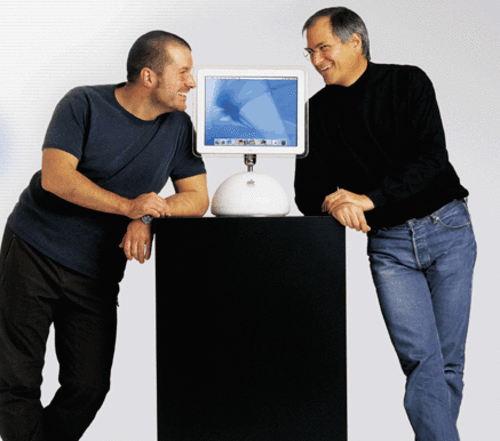British born Jonathan Ive, head of Design at Apple, is the lesser-known mastermind behind the iPod, iMac, PowerBook G4, MacBook, G4 Cube, unibody MacBook Pro, iPhone and iPad. Without his dedication to simplicity and functional design, the Apple products that exist today may not have become a reality without Ive. What initially sparked his interest in design was his love for cars as a teenager. Thankfully for us, immature fellow peers kept him from pursuing car design any further so he set off to Newcastle Polytechnic to immerse himself in industrial design. The work that followed in the years after has garnered him awards and attention all over the world.
Before coming to work for Apple, Ive bounced around between design agencies but was not wholly satisfied with the work or the clients that he was taking on. Apple was the only one of his clients that he respected and they seemed to hold him in the same regard. During Ive’s two year stint as a consultant, Apple was insistent about him coming to work full-time for them. Apprehension kept him from going to America initially, Apple was not in the best fiscal position but in 1992 he finally agreed.
The pre-Steve Job years were a struggle for Ive, design took no precedence in the products that were being developed and sales were not good.
When Steve Jobs returned in 1996, the two men partnered up to become the most influential duo tech of the next two decades. In 1999, the iBook and PowerMac G4 were developed. The iBook was the first portable product to automatically switch on when it was opened and closed without a latch. PowerMac G4 was a series of personal computers designed for professional users who could gain immediate access to the internal components. The Titanium PowerBook G4 and a redesigned iBook, introduced in 2001, were some of the thinnest and lightest full-featured notebooks on the market at the time. The widescreen display format was designed to be expansive when in use and compact when closed.
Their major breakthrough, though, came when the iPod was released in 2001.
It revolutionized portable music devices; a small, sleek digital jukebox that could fit in your pocket and store thousands of songs was a revelation to music lovers. It has been regarded as a stunning feat of design engineering by showcasing Ive’s attention to detail. Based on a prototype of the iPod, Apple unveiled the iPhone in 2007. It completely changed the mobile landscape. Apart from calling and texting, the iPhone could also store music, videos, and pictures. The new app store offered downloads from various, outside developer apps that offered things like games, instant news, music, and took advantage of the burgeoning social media scene. With a built-in camera, sensors, and a variety of features to enhance user experience, it has remained a smartphone leader for years. Jony’s next idea was a tablet with a fully intuitive interface that would require no instructions on how to use. A lot of attention was given to choosing the materials that would be used, designing compatibility, and making it easy for people to just pick up and use the product. When the iPad was introduced introduced into the market it some people speculated that the device could potentially replace laptops. This remains to be seen.
Even though Steve Jobs passed away in 2011, Ive continues invigorating the design scene. One of Ive’s more recent developments is the iOS7 operating system, described by Apple as “the fastest software upgrade in history.” Features such as translucency, refined typography, new icons, layering, physics, and gyroscope-driven parallaxing highlight significant changes in the design. We at Fueled are sure that Ive will continue to do beautiful work whether it be for Apple or not.
By Ilan Nass. Fueled is the world’s premier development and strategy firm specializing in creating Android and iPhone apps.
Image Credit: stevejobsinc.blogspot.com





